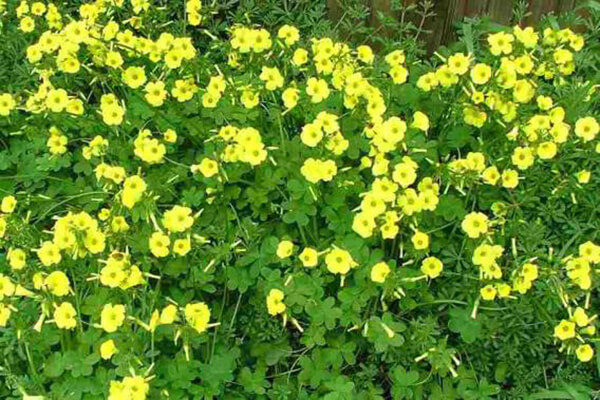
Soursob
Botanical name: Oxalis pes-caprae
Common Names
Also known as: Soursob, African wood sorrel, Bermuda buttercup, buttercup oxalis, Cape cowslip, Cape sorrel
Soursob Description
An almost hairless plant with long-stalked, trifoliate leaves that often have dark spots. Soursob is often mistaken for clover. However, while they both can have a similar appearance with trifoliate sectioned leaves, oxalis is easily distinguishable by having heart-shaped leaves compared to the oval-shaped leaves of clover.
STEM AND LEAVES
The leaves emerge from the top of an underground stem (i.e. rhizome) at or just below the soil surface. They are borne on long stalks (i.e. petioles) 5-22 cm long and consist of three heart-shaped (i.e. obcordate) leaflets. These leaflets (5-30 mm long and 4-35 mm wide) are mostly green in colour, sometimes bearing brown or purple-coloured markings, and fold downwards during darkness. They are hairless with entire margins and deeply-notched tips (i.e. emarginate apices).
FLOWERS AND FRUITS
The bright yellow flowers (25-40 mm across) are borne in loose clusters (each with 3-25 flowers) at the top of the stems on individual stalks (i.e. pedicels) up to 20 mm long. They are trumpet-shaped (i.e. tubular) in appearance with five broad overlapping petals (15-25 mm long) that are fused together towards their bases. These flowers also have five sepals, ten stamens and an ovary topped with five styles. They open only during sunny conditions and close again at night or during dull conditions. Flowering occurs mainly from early winter through to late spring (i.e. from May to November).
The short capsules are rarely formed in Australia.
REPRODUCTION AND DISPERSAL
This species most commonly reproduces via underground bulbs and bulbils (seeds are rarely produced in Australia). The cone-shaped (i.e. conical) bulbs are white, fleshy segments (8-30 mm long) covered in brown scales, while the bulbils are smaller and generally lack the brown covering of scales.
Bulbs and bulbils are most commonly spread by cultivation and other forms of soil movement. They are also dispersed to new areas in contaminated soil, in dumped garden waste, by water movement and by animals (e.g. birds).
SIMILAR SPECIES
There are approximately 30 species of Oxalis in Australia
Reference: https://weeds.brisbane.qld.gov.au/
